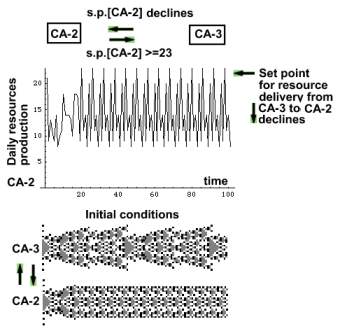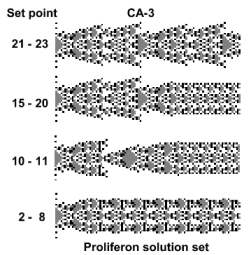 |
Three
CA solution
In the previous experiment a two process proliferon was required to deliver diverse amounts of resources. Nevertheless it always attained a solution (attractor). The present proliferon consists of three processes (CA). A stem and two transitory processes which interact and exchange resources. The system will never die and has two outcomes:
1. Irregular
oscillations.
2. Solutions (regular oscillations)
The CA changes
its structure only when losing resources and cells die. On the other hand, when accumulating
resources it maintains its structure.
In the present experiment CA-2 daily resource production triggers
the appearance of itself and of CA-3. The set point (s. p.) which triggers resource
delivery from CA-2 to CA-3 is >=23 and CA-2 structure remains constant
The set point triggering resource delivery from CA-3 to CA-2 declines,
CA-3 delivers more and more resources and its structure changes. The
experiment is run 23 times. Prior to each run the set point is reduced
by one.
 |
As
CA-3 delivers more and more resources, its structure changes. At
some set points it oscillates irregularly ( 9, and 12 – 14, not depicted). The image depicts only solutions.
 |
- At set points
21 – 23 the proliferon attains its first solution.
CA-3 and CA-2 are isolated and their structure does not change.
- At
set points 10 – 11, and 15 – 20, both processes attain the
same solution and oscillate synchronously.
- At set points 9, and 12 – 14 CA-3 oscillates irregularly (not depicted).
- At set points 2 –
8 CA-3 attains a new solution.
Novelty
The first solution ( 21 –23 ) is trivial since
it is displayed by any non interacting CA.
The second solution
( 5 – 20 ) and the third (10 – 11) are copies
of CA-2.
The last solution (
2 – 8 ) is novel.
Here are some implementations:
- Apoptosis:
.The stem process kills diseased processes and plants a zygote instead
.
- Window of activity: Prevents the set point dropping below 15.
- Filter:
A fourth transitory process remembers unhealthy set points and prevents
CA-3 from responding to their trigger.
- The stem process controls process structure, which
will be demonstrated in the next experiment
Setup
nca=3; restoreparams[1,1,1];
restoreparams[2,1,1]; restoreparams[3,1,1];
If[sa[[2]] >=23 ,donate[3, 2]]; If[ sa[[3]] > sa[[2]] &&
sa[[2]] >= k, donate[3, 2]]; {k,, 23, 2, -1}; If[nowdat[[no,8]] <= 2, newzygote[no]];